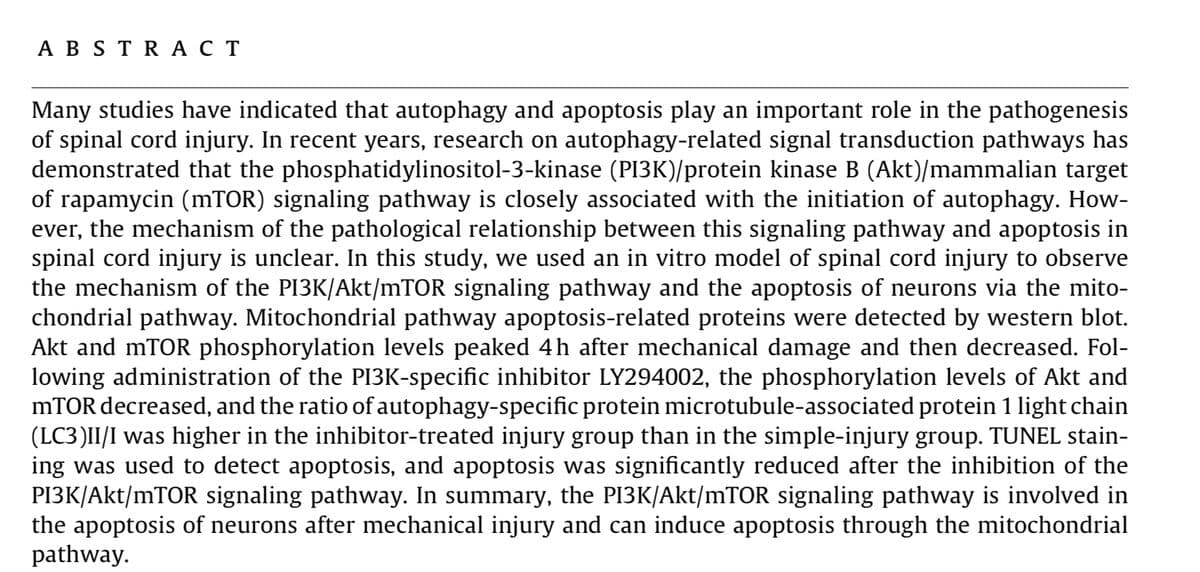Many studies have indicated that autophagy and apoptosis play an important role in the pathogenesis of spinal cord injury. In recent years, research on autophagy-related signal transduction pathways has demonstrated that the phosphatidylinositol-3-kinase (PI3K)/protein kinase B (Akt)/mammalian target of rapamycin (MTOR) signaling pathway is closely associated with the initiation of autophagy. How- ever, the mechanism of the pathological relationship between this signaling pathway and apoptosis in spinal cord injury is unclear. In this study, we used an in vitro model of spinal cord injury to observe the mechanism of the PI3K/Akt/mTOR signaling pathway and the apoptosis of neurons via the mito- chondrial pathway. Mitochondrial pathway apoptosis-related proteins were detected by western blot. Akt and mTOR phosphorylation levels peaked 4h after mechanical damage and then decreased. Fol- lowing administration of the PI3K-specific inhibitor LY294002, the phosphorylation levels of Akt and mTOR decreased, and the ratio of autophagy-specific protein microtubule-associated protein 1 light chain (LC3)II/I was higher in the inhibitor-treated injury group than in the simple-injury group. TUNEL stain- ing was used to detect apoptosis, and apoptosis was significantly reduced after the inhibition of the PI3K/Akt/MTOR signaling pathway. In summary, the PI3K/Akt/MTOR signaling pathway is involved in the apoptosis of neurons after mechanical injury and can induce apoptosis through the mitochondrial pathway.
Many studies have indicated that autophagy and apoptosis play an important role in the pathogenesis of spinal cord injury. In recent years, research on autophagy-related signal transduction pathways has demonstrated that the phosphatidylinositol-3-kinase (PI3K)/protein kinase B (Akt)/mammalian target of rapamycin (MTOR) signaling pathway is closely associated with the initiation of autophagy. How- ever, the mechanism of the pathological relationship between this signaling pathway and apoptosis in spinal cord injury is unclear. In this study, we used an in vitro model of spinal cord injury to observe the mechanism of the PI3K/Akt/mTOR signaling pathway and the apoptosis of neurons via the mito- chondrial pathway. Mitochondrial pathway apoptosis-related proteins were detected by western blot. Akt and mTOR phosphorylation levels peaked 4h after mechanical damage and then decreased. Fol- lowing administration of the PI3K-specific inhibitor LY294002, the phosphorylation levels of Akt and mTOR decreased, and the ratio of autophagy-specific protein microtubule-associated protein 1 light chain (LC3)II/I was higher in the inhibitor-treated injury group than in the simple-injury group. TUNEL stain- ing was used to detect apoptosis, and apoptosis was significantly reduced after the inhibition of the PI3K/Akt/MTOR signaling pathway. In summary, the PI3K/Akt/MTOR signaling pathway is involved in the apoptosis of neurons after mechanical injury and can induce apoptosis through the mitochondrial pathway.
Biology 2e
2nd Edition
ISBN:9781947172517
Author:Matthew Douglas, Jung Choi, Mary Ann Clark
Publisher:Matthew Douglas, Jung Choi, Mary Ann Clark
Chapter9: Cell Communication
Section: Chapter Questions
Problem 12RQ: Histamine binds to the H1 G-protein-linked receptor to initiate the itchiness and airway...
Related questions
Concept explainers
Question
Can I get help constructing a concept map?

Transcribed Image Text:A B S T R A C T
Many studies have indicated that autophagy and apoptosis play an important role in the pathogenesis
of spinal cord injury. In recent years, research on autophagy-related signal transduction pathways has
demonstrated that the phosphatidylinositol-3-kinase (PI3K)/protein kinase B (Akt)/mammalian target
of rapamycin (mTOR) signaling pathway is closely associated with the initiation of autophagy. How-
ever, the mechanism of the pathological relationship between this signaling pathway and apoptosis in
spinal cord injury is unclear. In this study, we used an in vitro model of spinal cord injury to observe
the mechanism of the PI3K/Akt/mTOR signaling pathway and the apoptosis of neurons via the mito-
chondrial pathway. Mitochondrial pathway apoptosis-related proteins were detected by western blot.
Akt and mTOR phosphorylation levels peaked 4h after mechanical damage and then decreased. Fol-
lowing administration of the PI3K-specific inhibitor LY294002, the phosphorylation levels of Akt and
MTOR decreased, and the ratio of autophagy-specific protein microtubule-associated protein 1 light chain
(LC3)II/I was higher in the inhibitor-treated injury group than in the simple-injury group. TUNEL stain-
ing was used to detect apoptosis, and apoptosis was significantly reduced after the inhibition of the
PI3K/Akt/mTOR signaling pathway. In summary, the PI3K/Akt/mTOR signaling pathway is involved in
the apoptosis of neurons after mechanical injury and can induce apoptosis through the mitochondrial
pathway.
Expert Solution
This question has been solved!
Explore an expertly crafted, step-by-step solution for a thorough understanding of key concepts.
This is a popular solution!
Trending now
This is a popular solution!
Step by step
Solved in 2 steps with 1 images

Knowledge Booster
Learn more about
Need a deep-dive on the concept behind this application? Look no further. Learn more about this topic, biology and related others by exploring similar questions and additional content below.Recommended textbooks for you

Biology 2e
Biology
ISBN:
9781947172517
Author:
Matthew Douglas, Jung Choi, Mary Ann Clark
Publisher:
OpenStax

Human Physiology: From Cells to Systems (MindTap …
Biology
ISBN:
9781285866932
Author:
Lauralee Sherwood
Publisher:
Cengage Learning

Biology (MindTap Course List)
Biology
ISBN:
9781337392938
Author:
Eldra Solomon, Charles Martin, Diana W. Martin, Linda R. Berg
Publisher:
Cengage Learning

Biology 2e
Biology
ISBN:
9781947172517
Author:
Matthew Douglas, Jung Choi, Mary Ann Clark
Publisher:
OpenStax

Human Physiology: From Cells to Systems (MindTap …
Biology
ISBN:
9781285866932
Author:
Lauralee Sherwood
Publisher:
Cengage Learning

Biology (MindTap Course List)
Biology
ISBN:
9781337392938
Author:
Eldra Solomon, Charles Martin, Diana W. Martin, Linda R. Berg
Publisher:
Cengage Learning